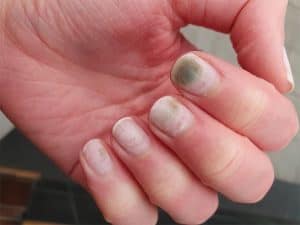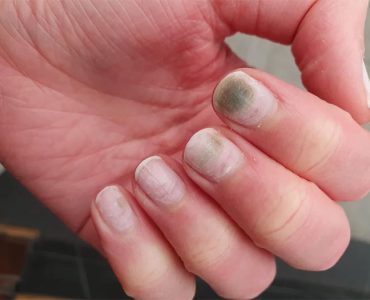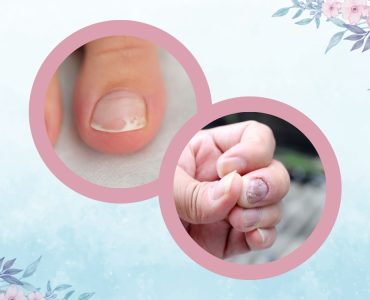Nail fungus, also known as onychomycosis, is a common condition that affects millions of people worldwide. It can be a persistent and frustrating problem, causing discolored, thickened, and brittle nails. If left untreated, nail fungus can lead to pain and discomfort, as well as potential complications.

Fortunately, there are various treatment options available to combat this condition and restore healthy nails. In this article, we will delve into the causes, symptoms, prevention, and effective treatment methods for nail fungus.
What is Nail Fungus?
Nail fungus, scientifically known as onychomycosis, is a common condition that affects the nails, particularly the toenails, although it can also occur in fingernails. It is caused by a fungal infection that invades the nail bed, leading to various characteristic symptoms. Understanding the nature of nail fungus is crucial in order to effectively treat and manage this condition.
Definition and Characteristics
Nail fungus is a fungal infection that primarily affects the nails, causing them to become discolored, thickened, and brittle. The most commonly affected areas are the toenails, as they provide an ideal environment for fungal growth due to the warm and moist conditions that often occur in shoes and socks. However, fingernails can also be affected, especially in individuals who frequently expose their hands to water or have compromised immune systems.
Development and Spread
Nail fungus typically starts as a small infection on or beneath the edge of the nail. As the infection progresses, it can spread deeper into the nail bed and the surrounding tissues. Fungi, including dermatophytes, yeasts, and molds, are responsible for the infection.
These organisms thrive in warm, moist environments and can easily spread from person to person or from one nail to another. Without proper treatment, nail fungus can persist and worsen over time.
Signs and Symptoms
Nail fungus presents several characteristic signs and symptoms that are important to recognize. One common symptom is the discoloration of the affected nails, which can range from yellowish-brown to white or black.
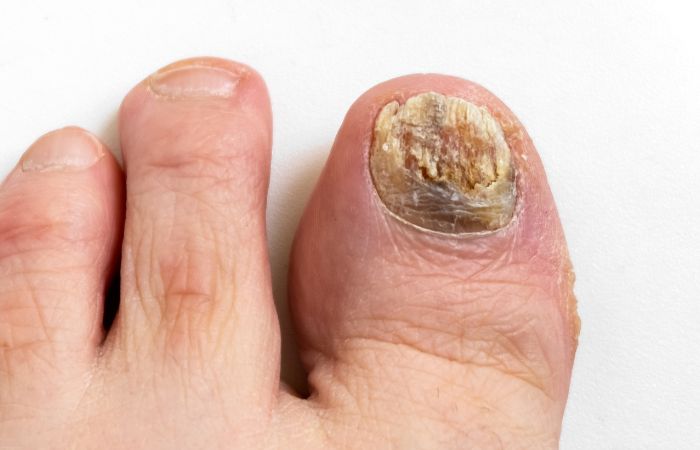
Additionally, infected nails may become thicker and develop an uneven, crumbly texture. As the infection progresses, the nails may become brittle and prone to breakage. Some individuals may also experience discomfort or pain, particularly when pressure is applied to the affected nails. In some cases, a foul odor may accompany the infection.
Identifying Nail Fungus
Identifying nail fungus is essential to differentiate it from other nail conditions and seek appropriate treatment. Recognizing the signs and symptoms associated with nail fungus can help individuals take early action and prevent the infection from progressing further. Here, we will discuss how to identify nail fungus and distinguish it from other similar nail conditions.
Signs and Symptoms
Nail fungus exhibits distinct signs and symptoms that can vary in severity and presentation. The most common indicators include changes in the appearance and texture of the affected nails. Discoloration is a key characteristic, with nails often turning yellow, brown, white, or even black.
Read This Next:
The discoloration typically starts at the tip or edges of the nail and gradually spreads toward the cuticle. Infected nails may also become thicker, resulting in a distorted or irregular shape. The texture of the nail may become rough, brittle, or crumbly. Furthermore, the affected nails may lose their natural shine and appear dull or matte.
Differential Diagnosis
While nail fungus shares similarities with other nail conditions, it is important to differentiate it from these ailments to ensure proper treatment. Conditions such as psoriasis, eczema, trauma-related nail damage, or bacterial infections can mimic some symptoms of nail fungus.
However, they may require different approaches for effective management. Consulting a healthcare professional or a dermatologist is recommended to obtain an accurate diagnosis and suitable treatment plan.
Medical Examination
To confirm the presence of nail fungus, a healthcare professional may conduct a thorough examination. This may involve visually inspecting the affected nails, assessing their texture, color, and shape. In some cases, a nail sample may be collected for laboratory testing, such as a fungal culture or microscopy. These tests help identify the specific fungi responsible for the infection and guide the choice of appropriate treatment.
Causes and Risk Factors
Understanding the causes and risk factors associated with nail fungus can help individuals take preventive measures and reduce their susceptibility to the infection. Nail fungus is typically caused by fungal organisms, and several factors can increase the likelihood of developing the condition. Let’s explore the primary causes and risk factors of nail fungus.
Fungal Infections
Nail fungus is predominantly caused by fungal organisms, including dermatophytes, yeasts, and molds. These organisms thrive in warm and moist environments, making the feet an ideal breeding ground. Fungal infections can enter the nail through small cuts or separations between the nail and nail bed, leading to the development of nail fungus.
Poor Foot Hygiene
Inadequate foot hygiene can contribute to the development of nail fungus. Failure to keep the feet clean and dry, especially after sweating or exposure to moisture, can create an environment that promotes fungal growth. Lack of proper foot hygiene practices increases the risk of fungal infections, including nail fungus.
Damaged Nails or Skin
Nails that are already damaged or compromised are more susceptible to nail fungus. Conditions such as nail trauma, repetitive injury, or previous nail infections can weaken the nail’s protective barrier, allowing fungi to invade and cause an infection. Similarly, skin conditions like athlete’s foot (fungal infection on the skin of the feet) can spread to the nails and result in nail fungus.
Weakened Immune System
Individuals with weakened immune systems, such as those with diabetes, HIV/AIDS, or undergoing immunosuppressive therapy, have an increased risk of developing nail fungus. A compromised immune system makes it harder for the body to fight off fungal infections, allowing them to take hold and cause nail fungus more easily.
Warm and Moist Environments
Fungi thrive in warm and moist environments, creating a favorable breeding ground for nail fungus. Certain occupations or activities that involve prolonged exposure to warm and damp conditions, such as wearing tight-fitting shoes or working in wet environments, can increase the risk of nail fungus development.
Prevention Tips
Taking proactive measures to prevent nail fungus can significantly reduce the risk of developing this common and bothersome condition. By adopting healthy habits and following preventive strategies, individuals can maintain the health and integrity of their nails. Here are some effective prevention tips to keep nail fungus at bay.
Good Foot Hygiene
Practicing good foot hygiene is paramount in preventing nail fungus. Regularly wash your feet with soap and warm water, paying close attention to the spaces between the toes. After washing, thoroughly dry your feet, including the areas between the toes, as moisture can promote fungal growth. Avoid walking barefoot in public places like pools, gyms, and communal showers, and always wear clean and dry socks.
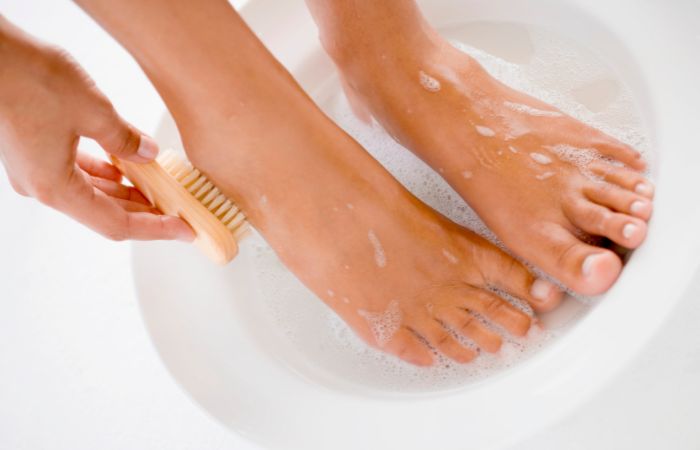
Proper Nail Care
Keeping your nails clean and properly trimmed is essential for preventing nail fungus. Trim your nails straight across and file down any thickened areas or rough edges. Avoid cutting the nails too short or cutting the cuticles, as these can create openings for fungi to enter. Use clean and sanitized nail clippers and other nail care tools to prevent the spread of fungal infections.
Breathable Footwear and Socks
Choose breathable footwear made of natural materials such as leather or canvas. These materials allow air circulation and reduce moisture buildup, creating an unfavorable environment for fungi. Avoid tight-fitting shoes that can cause excessive sweating and moisture retention. Opt for moisture-wicking socks made of materials like cotton or wool, as they help keep the feet dry and prevent fungal growth.
Avoid Sharing Personal Items
Fungal infections, including nail fungus, can spread through direct contact with contaminated items. Avoid sharing personal items such as towels, socks, shoes, or nail care tools with others, especially if they have a known nail fungus infection. This reduces the risk of cross-contamination and helps maintain nail health.
Healthy Lifestyle Habits
Adopting healthy lifestyle habits can contribute to overall nail health and reduce the risk of nail fungus. Maintain a balanced diet that includes essential nutrients to strengthen the immune system and promote healthy nail growth. Regular exercise improves blood circulation, including to the nails, which aids in their health. Avoid smoking, as it can impair blood flow and increase the risk of nail fungus.
Home Remedies and Natural Treatments
While medical interventions are often recommended for treating nail fungus, some individuals may prefer to explore home remedies and natural treatments as a complementary approach or initial step.
It’s important to note that home remedies may not provide the same level of efficacy as clinically proven treatments, and results can vary from person to person. However, here are some popular home remedies and natural treatments that have been suggested for nail fungus:
Vinegar Soaks
Vinegar, particularly apple cider vinegar, is often touted as a potential remedy for nail fungus. The acidity of vinegar creates an inhospitable environment for fungi. To try this method, mix equal parts of vinegar and warm water in a basin or tub. Soak the affected nails in the solution for 15-20 minutes daily. Pat the nails dry afterward.
Tea Tree Oil
Tea tree oil is known for its antifungal and antiseptic properties. Apply a few drops of tea tree oil directly to the affected nails and gently massage it in. Leave it on for 10-15 minutes before rinsing it off or wiping away the excess oil. Repeat this process twice daily.
Oregano Oil
Oregano oil has natural antifungal properties that may help combat nail fungus. Dilute a few drops of oregano oil with a carrier oil, such as olive oil or coconut oil. Apply the mixture to the affected nails and let it sit for 30 minutes before rinsing it off. Repeat this process once or twice daily.
Read This Next:
Garlic Paste
Garlic is believed to have antifungal properties. Crush a few garlic cloves to create a paste and apply it directly to the affected nails. Leave it on for 30 minutes before rinsing it off. Repeat this process daily until you see improvement.
Essential Oils
Several essential oils, such as lavender oil, clove oil, and eucalyptus oil, are known for their antifungal properties. Dilute a few drops of the essential oil of your choice with a carrier oil and apply it to the affected nails. Leave it on for a few hours or overnight before washing it off. Repeat this process daily or as needed.
When to Seek Professional Help
While home remedies and over-the-counter treatments can be attempted for mild cases of nail fungus, it is important to recognize when it is necessary to seek professional help. Consulting a healthcare professional or a dermatologist is recommended in the following situations:
Severe or Recurring Infections
If the nail fungus infection is severe, causing significant pain, discomfort, or impairment in daily activities, it is advisable to seek professional assistance. Additionally, if the infection keeps recurring despite attempts to treat it at home, a healthcare professional can provide a more comprehensive assessment and recommend appropriate treatment options.
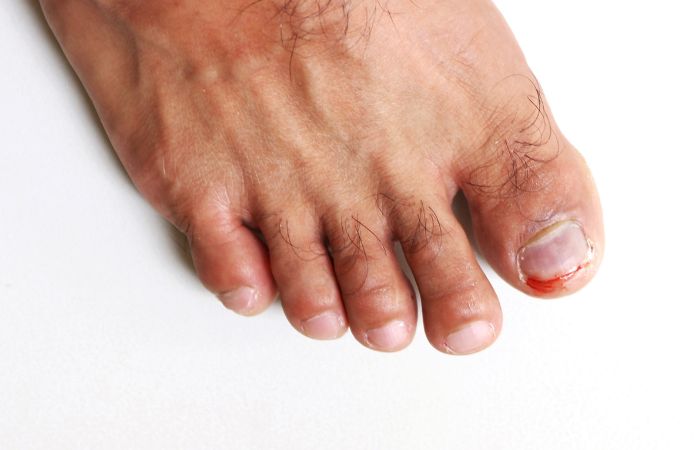
Pain or Discomfort
Nail fungus infections can cause discomfort, especially when pressure is applied to the affected nails. If you experience pain, inflammation, or persistent discomfort related to the infection, it is important to consult a healthcare professional. They can evaluate the extent of the infection, provide pain management strategies, and recommend suitable treatment options.
Diabetic or Compromised Immune System
Individuals with underlying medical conditions, such as diabetes or a compromised immune system, are more susceptible to infections, including nail fungus. Due to the potential complications and risks associated with these conditions, it is crucial for individuals with diabetes or a weakened immune system to seek professional help promptly when nail fungus is suspected or identified.
Spreading to Other Nails or Skin
If the nail fungus infection spreads to other nails or nearby skin, it may require professional intervention. Fungal infections can easily spread from one area to another, and prompt treatment can help contain the infection and prevent further spread.
Lack of Improvement with Home Treatments
If you have diligently tried home remedies and over-the-counter treatments for a significant period of time (usually several weeks or months) without seeing any improvement in the condition, it is advisable to consult a healthcare professional. They can evaluate the situation, provide a proper diagnosis, and recommend more targeted and effective treatment options.
Conclusion
Nail fungus is a widespread condition that affects people of all ages and backgrounds. Its impact extends beyond cosmetic concerns, often causing discomfort and even affecting self-confidence. However, understanding the causes, symptoms, prevention, and treatment options can significantly help in combating this common ailment.
Whether you opt for home remedies, over-the-counter treatments, or consult a healthcare professional, addressing nail fungus early on is essential to prevent its progression and potential complications.


